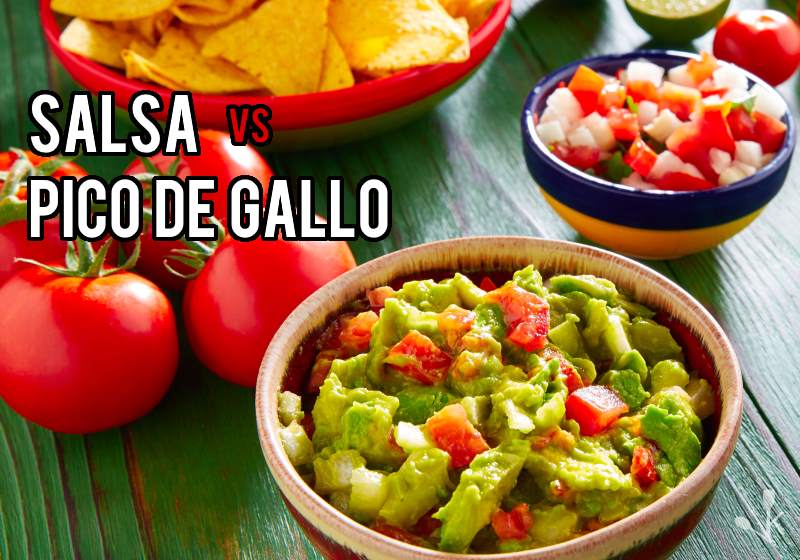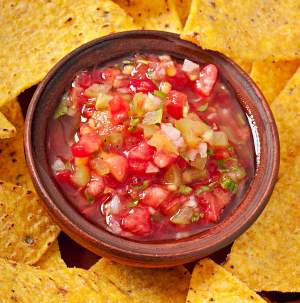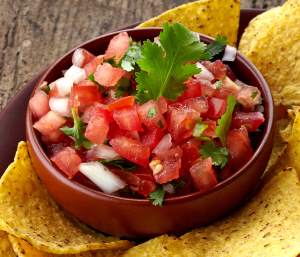Corn chips serve as a delectable vehicle for a wonderful variety of foods, including guacamole, picante sauce, salsa, salsa Fresca and Pico de Gallo.
While picante sauce, salsa, salsa Fresca and Pico de Gallo often have the same ingredients (Tomatoes, Onions, Peppers, Garlic and Cilantro), the preparation and thus the texture can be quite different.

While cilantro can fall into the “yuck” column for many diners, it’s hard to fault a good combination of tomatoes, onion, garlic and peppers.
When preparing or purchasing any tomato based food sauce commonly assigned to Mexican food, it’s important to consider texture and heat or spiciness.
Salsa Meaning

In Spanish, “salsa” literally translates to “sauce”.
While some salsas are cooked, there are several very simple salsa recipes that can be prepared with canned tomatoes, mild or bell peppers, garlic and onion.
Throw them in a blender or food processors until everything is chunky and serve.
Salsa ingredients should technically be recognizable; peppers, onion and tomato chunks should be visible in the sauce.
What Is Salsa Picante?
The difference between salsa and picante in Spanish is that “salsa = sauce” and “picante = hot”, so though it may be confusing, you can purchase picante salsa. Both combinations of produce are blended into a sauce before serving.
Picante sauce also has a tomato base, but generally uses hotter peppers, stronger onions and more garlic.
Picante sauce is also much smoother in texture, so if you’re blending up picante sauce, let the food processor work on it until it’s soupier and smoother than salsa.
What Is Salsa Fresca?
Salsa Fresca literally translates to “fresh salsa” or chopped (as opposed to processed) salsa.
A review of salsa Fresca recipes indicates that this dish is a variation on Pico de Gallo; again, including the standard tomato combination but also including fresh avocado, a little olive oil, jicama or corn.
Pico de Gallo Meaning

Pico de Gallo literally translates to “Pico = spicy, or beak (as in bird)” and “Gallo = rooster”, which leads to a lot of confusion.
However, this Pico de Gallo translation makes a lot more sense when you consider that this dish was once eaten with fingers pinched, like the beak of a rooster.
Pico de Gallo is not saucy or blended, but instead is comprised only of fresh chopped tomatoes, onion, jalapeno, lime juice to keep things fresh, garlic and cilantro to taste.
This basic dish can easily be turned into a tasty and rather hearty dish with the addition of chopped jicama and fresh corn.
Fresh Pico de Gallo should not have any extra liquid or soupiness in presentation except for the lime juice and a bit of juice from the fresh tomatoes.
The fundamental difference between salsa and Pico de Gallo is that you can make salsa in a food processor; Pico de Gallo needs to be chopped.
Is Pico de Gallo salsa? In that it’s a combination of salsa or picante ingredients, yes. However, the preparation and final flavor combination is very different from salsa. Pico de Gallo is chopped, not processed, and there should not be any tomato “sauce” in Pico de Gallo.
Expansion of the Word “Salsa”
It’s interesting to note that many dishes called “salsa” have very little tomato sauce in them. Recent variations on anything you can eat from a corn chip include several unique and unusual features.
For example, a dip called Texas Caviar or Texas Salsa primarily features black-eyed peas or black beans as the main ingredient.
It also contains garlic, onion, cilantro and tomatoes. It can be prepared with canned tomatoes and jalapenos, commonly referred to by the brand name Rotel.
Prepare this delicious dip with fresh tomatoes in a Pico de Gallo style. While this is not a traditional salsa in that it’s not smooth or even tomato based, it’s a delicious way to enjoy corn chips.
Final Thoughts
Fans of the cuisine known as Tex-Mex may be surprised to try to find anything from this food tradition when actually dining in Mexico; the tradition of Tex-Mex was developed in the United States.
Salsa, salsa Fresca, picante sauce and Pico de Gallo may have all started as flavors tied to Hispanic cuisines, but the American fascination with the corn chip has turned salsa into a separate food category.
America has often been called a melting pot, but the cuisine of the United States is more of a salad; a large mish-mash of varying influences, merged into some very unique combinations.
Salsa, whether chopped like Pico de Gallo or blended like picante, is a nutritious and delicious condiment.











